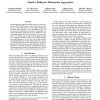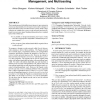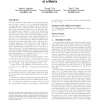580 search results - page 100 / 116 » Choosing a random peer |
CVPR
2012
IEEE
11 years 9 months ago
2012
IEEE
Attributes are visual concepts that can be detected by machines, understood by humans, and shared across categories. They are particularly useful for fine-grained domains where c...
AAAI
2012
11 years 9 months ago
2012
The flourishing of online labor markets such as Amazon Mechanical Turk (MTurk) makes it easy to recruit many workers for solving small tasks. We study whether information elicita...
SIGMOD
2001
ACM
14 years 7 months ago
2001
ACM
In this paper, we investigate how to scale hierarchical clustering methods (such as OPTICS) to extremely large databases by utilizing data compression methods (such as BIRCH or ra...
SPAA
2004
ACM
14 years 25 days ago
2004
ACM
The tremendous growth of public interest in peer-to-peer systems in recent years has initiated a lot of research work on how to design efficient and robust overlay networks for t...
STOC
2009
ACM
14 years 8 months ago
2009
ACM
The low-rank matrix approximation problem involves finding of a rank k version of a m ? n matrix AAA, labeled AAAk, such that AAAk is as "close" as possible to the best ...



